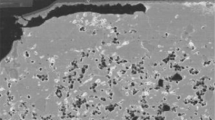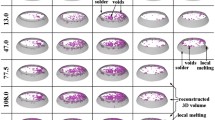Abstract
In this work, analysis of electromigration-induced void morphological evolution in solder interconnects is performed based on mass diffusion theory. The analysis is conducted for three typical experimentally observed void shapes: circular, ellipse, and cardioid. Void morphological evolution is governed by the competition between the electric field and surface capillary force. In the developed model, both the electric field and capillary force on the void’s surface are solved analytically. Based on the mass conversation principle, the normal velocity on the void surface during diffusion is obtained. The void morphological evolution behavior is investigated, and a physical model is developed to predict void collapse to a crack or to split into sub-voids under electric current. It is noted that when the electric current is being applied from the horizontal direction, a circular void may either move stably along the electric current direction or collapse to a finger shape, depending on the relative magnitude of the electric current and surface capillary force. However, the elliptical-shaped void will elongate along the electric current direction and finally collapse to the finger shape. On the other hand, the cardioid-shaped void could bifurcate into two sub-voids when the electric current reaches a critical value. The theoretical predictions agree well with the experimental observations.









Similar content being viewed by others
References
Subramanian, S.J., Sofronis, P., Ponte, C.: Void growth in power-law creeping solids: effect of surface diffusion and surface energy. Int. J. Solids Struct. 43, 6202–6225 (2005)
Gao, H.: Probing mechanical principles of cell-nanomaterial interactions. J. Mech. Phys. Solids 62, 312–339 (2014)
Pharr, G.M., Nix, W.D.: A numerical study of cavity growth controlled by surface diffusion. Acta Metall. 27, 1615–1631 (1979)
Liu, Y., Zhang, H., Zhang, J.: Transient swelling of polymeric hydrogels: a new finite element solution framework. Int. J. Solids Struct. 80, 246–260 (2016)
Kim, D.C., Lu, W.: Creep flow, diffusion, and electromigration in small scale interconnects. J. Mech. Phys. Solids 54, 2554–2568 (2006)
Tu, K.N.: Recent advances on electromigration in very-large-scale-integration of interconnects. J. Appl. Phys. 94, 5451–5473 (2003)
Gee, S., Kellkar, N., Huang, J., et al.: Lead-free and PbSn bump electromigration. In: ASME Pacific Rim Technical Conference and Exhibition on Integration and Packaging of MEMS, San Francisco, 1313–1321 (2005)
Liu, C.Y., Chen, C., Tu, K.N.: Electromigration in Sn–Pb solder strips as a function of alloy composition. J. Appl. Phys. 88, 5703–5709 (2000)
Wang, W., Suo, Z., Hao, T.: A simulation of electromigration-induced transgranular slits. J. Appl. Phys. 79, 2394–2403 (1996)
Marieb, T., Bravman, J.C., Flinn, P.: Observation of voids induced by mechanical stress and electromigration in passivated Al lines deposited at different purity levels. Appl. Phys. Lett. 64, 2424–2426 (1994)
Yeh, E.C.C., Choi, W.J., Tu, K.N.: Current-crowding-induced electromigration failure in flip chip solder joints. Appl. Phys. Lett. 80, 580–582 (2002)
Xia, L., Bower, A.F., Suo, Z.: A finite element analysis of the motion and evolution of voids due to strain and electromigration induced surface diffusion. J. Mech. Phys. Solids 45, 1473–1493 (1997)
Averbuch, A., Israeli, M.: Ravve, I.: Electromigration of intergranular voids in metal films for microelectronic interconnects. J. Comput. Phys. 86, 481–502 (2003)
Yang, W., Wang, W., Suo, Z.: Cavity and dislocation instability due to electric current. J. Mech. Phys. Solids 42, 897–911 (1994)
Suo, Z., Wang, W., Yang, M.: Electromigration instability: transgranular slits in interconnects. Appl. Phys. Lett. 64, 1944–1946 (1994)
Schimschak, M., Krug, J.: Surface electromigration as a moving boundary value problem. Phys. Rev. Lett. 78, 278–281 (1997)
Li, Y., Li, Z., Wang, X.: Analytical solution for motion of an elliptical inclusion in gradient stress field. J. Mech. Phys. Solids 58, 1001–1010 (2010)
Yao, Y., Keer, L.M., Fine, M.E.: Electromigration effect on pancake type void propagation near the interface of bulk solder and intermetallic compound. J. Appl. Phys. 8, 063710–063710 (2009)
Rice, J.R., Chuang, T.J.: The shape of intergranular creep cracks growing by surface diffusion. Acta. Metall. 21, 1625–1628 (1973)
Einstein, A.: The motion of elements suspended in static liquids as claimed in the molecular kinetic theory of heat. Ann. Phys. 322, 549–560 (1905)
Arzt, E., Kraft, O., Nix, W.D.: Electromigration failure by shape change of voids in bamboo lines. J. Appl. Phys. 76, 1563–1571 (1994)
Ho, P.S.: Motion of inclusion by a direct current and a temperature gradient. J. Appl. Phys. 41, 64–68 (1970)
Hasebe, N., Bucher, C., Heuer, R.: Heat conduction and thermal stress induced by an electric current in an infinite thin plate containing an elliptical hole with an edge crack. Int. J. Solids Struct. 47, 138–147 (2010)
Yao, Y., Wang, Y., Keer, L.M., et al.: An analytical method to predict electromigration-induced finger-shaped void growth in SnAgCu solder interconnect. Scr. Mater. 95, 7–10 (2015)
Muskhelishvili, N.I.: Some Basic Problems of the Mathematical Theory of Elasticity. Noordhoff, Groningen (1953)
He, D., Huang, P.Z.: A finite-element analysis of in-grain microcracks caused by surface diffusion induced by electromigration. Int. J. Solids Struct. 62, 248–255 (2015)
Decuzzi, P., Ferrari, M.: The receptor-mediated endocytosis of nonspherical particles. Biophys. J. 94, 3790–3797 (2008)
Acknowledgements
This work was supported by the National Natural Science Foundation of China (Grant 11572249), the Aerospace Technology Foundation (Grant N2014KC0068), and the Aeronautical Science Foundation of China (Grant N2014KC0073).
Author information
Authors and Affiliations
Corresponding author
Rights and permissions
About this article
Cite this article
Wang, Y., Yao, Y. A theoretical analysis of the electromigration-induced void morphological evolution under high current density. Acta Mech. Sin. 33, 868–878 (2017). https://doi.org/10.1007/s10409-017-0645-z
Received:
Revised:
Accepted:
Published:
Issue Date:
DOI: https://doi.org/10.1007/s10409-017-0645-z




